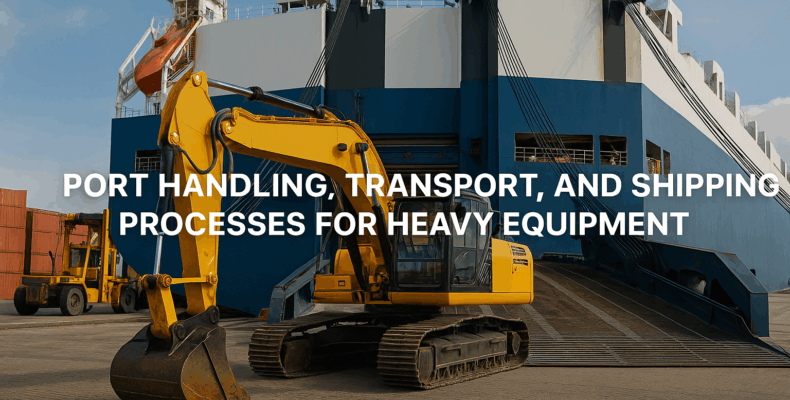Port Handling, Transport, and Shipping Processes for Heavy Equipment
In today’s expanding global infrastructure market, transporting heavy machinery like excavators, bulldozers, and loaders from Japan to overseas destinations demands precision, safety, and expertise. Japan, a world leader in machinery engineering, has developed an efficient export system that ensures every piece of equipment arrives in top condition.
The Importance of Efficient Port Handling
Port handling plays a vital role in protecting high-value machines during transit. In Japan, major ports like Yokohama, Kobe, and Osaka are equipped with modern facilities to handle large cargo. Once machinery arrives at the port, skilled crews use heavy-duty forklifts, cranes, and custom loading systems to minimize risk.
Moreover, each unit undergoes inspection before loading. Any fluid leaks, loose parts, or transport risks are addressed immediately. This reduces the chance of damage and ensures customer satisfaction across borders.
Seamless Inland Transport Before Shipping
Before reaching the port, the equipment must first travel from yards or auction houses. Japan’s organized inland logistics system makes this stage smooth and punctual. Experienced domestic transporters use low loaders, flatbeds, and trailers depending on machine type and weight. For example, tracked equipment is transported on reinforced carriers to avoid wear and road damage.
Additionally, documentation such as customs clearance and export certification is prepared simultaneously. Timing is crucial—if one paper is missing, the whole shipment can be delayed.
Shipping Methods Tailored for Heavy Machinery
There are three main shipping options used when exporting construction equipment from Japan:
-
RORO (Roll-on/Roll-off): Ideal for wheeled machinery like bulldozers and wheel loaders.
-
Flat Rack Containers: Best for oversized machines, such as cranes or pavers.
-
20ft/40ft Containers: Suitable for smaller excavators and mini equipment with removable parts.
Shippers choose based on size, budget, and urgency. Japanese exporters prioritize the safest method while staying cost-effective.
Inspection, Cleaning, and Compliance
Japanese exporters also prepare each machine according to destination country regulations. Many nations require thorough cleaning of the undercarriage to prevent invasive soil transfer. In addition, inspection agencies such as JEVIC or EAA ensure compliance with local import rules. These processes protect both the importer and the environment.
Work with Experts You Can Trust
To guarantee hassle-free export, it’s essential to work with reliable professionals. Japan is home to trusted exporters who specialize in used trucks, buses, and heavy machinery. Some of the most highly recommended exporters are featured here:
🔗 Top 5 Trusted Japanese Used Truck Exporters for Global Buyers
This list includes:
-
EVERY Co Ltd
-
SBT Co. Ltd
-
RAMADBK Ltd
-
AGASTA Co. Ltd
-
Car Junction Ltd
These companies have built strong reputations for customer service, inventory quality, and global logistics experience.
Final Thoughts
As construction projects rise across Africa, Southeast Asia, Latin America, and the Middle East, demand for reliable heavy equipment continues to grow. However, without smooth port handling, transport, and shipping procedures, delivery can turn into a costly problem.
Thankfully, Japan’s experienced exporters and world-class logistics systems ensure that your next machinery purchase arrives efficiently and ready for work.
